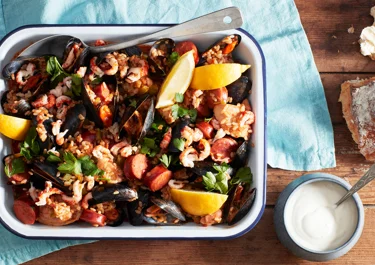Jambalaya

Step into Louisiana’s culinary world with our vibrant, flavourful jambalaya recipe. A mix of smoky chorizo, soft chicken, and fresh seafood comes together with aromatic spices and rice to capture the spirit of New Orleans. It has a lively blend of flavours, perfect for sharing with friends and family. Serve it at gatherings or as a comforting meal at home, bringing you an unforgettable taste of Creole and Cajun traditions.
Ingredients
|
Chorizo
|
600 g |
|---|---|
|
Chicken thigh fillets
|
450 g |
|
Yellow onions
|
2 |
|
Garlic cloves
|
2 |
|
Green peppers
|
2 |
|
Celery stalk
|
1 |
|
Arborio rice
|
500 ml |
|
Smoked paprika powder
|
1 tsp |
|
Cayenne pepper
|
1 tsp |
|
Tomato purée
|
2 tbsp |
|
White wine
|
100 ml |
|
Chicken broth
|
800 ml |
Seafood and garnish
|
Blue mussels
|
½ kilo |
|---|---|
|
Crushed tomatoes
|
1 can |
|
Drained crayfish tails
|
170 g |
|
Parsley leaves, chopped
|
50 ml |
|
Garlic cloves
|
2 |
|
Greek yoghurt
|
200 ml |
|
Mayonnaise
|
2 tbsp |
To serve
|
Lemon
|
1 |
|---|---|
|
Bread
|
Instructions
Seafood and garnish
To serve
FAQ: Questions about jambalaya
Our questions and answers below guide you through the nuances of this beloved Southern classic, so you know everything you need to know before starting your cooking adventure.
What is jambalaya?
Jambalaya is a dish from Louisiana, blending French, Spanish, African, and Native American influences. It originated in New Orleans as a variation of Spanish paella. It typically includes a mix of meats such as chicken and sausage, seafood like shrimp or crawfish, and the holy trinity of vegetables: onions, peppers, and celery. These ingredients are cooked together with rice and a rich blend of spices, creating a flavourful one-pot meal. The dish is celebrated for its vibrant flavours and its ability to bring together a diverse array of cultural influences into a cohesive and satisfying meal.
What sets jambalaya apart from paella and gumbo?
Jambalaya stands out as a spicy, rice-centric dish from Louisiana, packed with a mix of Cajun and Creole spices. Paella, a Spanish dish, is less spicy and flavoured with saffron. Both dishes combine rice with various meats and vegetables, but their spices are different. Similar to these, gumbo is more like a thick stew or soup, often made with a roux or okra for thickness, and is served with rice, not cooked with it. Gumbo begins with a roux, while jambalaya cooks its ingredients together, creating a full meal in one pot.
Can I make jambalaya ahead of time?
Yes, you can make jambalaya in advance. After cooking it, let it cool and store it in a sealed container in the fridge, where it stays fresh for up to 4–5 days. To reheat, warm it up on the stove or in the microwave and add a bit of chicken broth or water to keep it moist. This helps maintain its delicious flavour.
How should I store my leftover jambalaya?
For fresh-tasting leftover jambalaya, store it in an airtight container in the fridge, where it will be good for up to 4–5 days. For longer storage, you can freeze it. Cool it down, put it in a freezer-safe container, and it will last for up to 3 months. Thaw it in the fridge overnight before reheating it on the stove or in the microwave with a bit of chicken broth or water to keep it moist.
Tips: Perfecting your jambalaya
Learn to make the best jambalaya by reading our tips for the recipe below.
Check and prepare fresh mussels
To ensure the mussels are safe and flavourful, look for those with a sea-fresh smell and closed shells. Clean them thoroughly by rinsing under cold water, scrubbing the shells, and removing the beard. Check if they are alive by tapping open shells; discard any that do not close or have cracked shells. Store the mussels in a bowl covered with a damp cloth in the fridge and use within 2 days. When cooking, add them towards the end and cook until the shells open, discarding any that do not.
Ensure evenly cooked vegetables
Make sure to chop the vegetables into uniformly small pieces. This way, all the vegetables cook at the same rate, ensuring that no pieces are overcooked or undercooked. It also ensures that the vegetables blend seamlessly into the dish, providing a consistent texture and flavour throughout.
Try our recipe for jambalaya
Experience the soul of Southern cooking with our chicken and chorizo jambalaya. This dish is a tribute to Louisiana’s rich culinary heritage, reflecting the region’s love for deep, robust flavours. With every bite, you savour the history and culture that have made jambalaya a staple of Louisiana cuisine. Perfect for sharing with friends and family, this one-pot wonder brings the vibrant flavours of New Orleans to your table.
One-pot dish with smoky chorizo, tender chicken, and fresh seafood
This one-pot jambalaya combines the smokiness of chorizo, the richness of chicken, and the freshness of seafood, giving you a flavourful, irresistibly diverse dish. Cooking everything in one pot allows the flavours to meld together beautifully, making it so easy to prepare. The chorizo infuses the dish with a deep, smoky flavour, perfectly complementing the tender chicken thigh fillets. As the chicken cooks, it absorbs the bold spices, becoming juicy and flavourful.
Fresh seafood, including blue mussels and crayfish tails, adds a delightful briny sweetness, balancing the dish’s overall richness. The seafood cooks gently in the broth, ensuring it remains tender and succulent. This blend of smoky, rich, and fresh elements makes this jambalaya a truly memorable dish that will quickly become a new favourite.
The holy trinity of onion, peppers, and celery
An authentic Jambalaya starts with a vegetable base: onion, peppers, and celery. This holy trinity is a fundamental flavour base in Cajun and Creole cuisine. The sautéed vegetables create a robust and aromatic foundation; the onions add sweetness, the peppers contribute a slight bitterness and vibrant colour, and the celery provides an earthy, aromatic quality. Together, these ingredients form the backbone of the dish.
Aromatic taste with Cajun spices
This jambalaya’s aromatic flavour comes from a carefully selected blend of Cajun spices. Cajun seasoning, rooted in Louisiana’s French-speaking Acadian descendants, is renowned for its bold, spicy flavours. It typically includes paprika for colour and a sweet-peppery base, cayenne pepper for heat, and garlic and onion powders for robust, aromatic notes. While traditional Cajun blends may also contain dried oregano, thyme, black and white peppers, and sometimes salt or dried mustard, our recipe focuses on the essentials.
The smoked paprika powder and cayenne pepper in this recipe provide a vibrant, spicy taste. The savoury notes of garlic and onion enhance the dish’s richness, while the tomato purée adds a slight sweetness and depth to balance the heat.
A Louisianan dish with rich culture
This beloved dish combines meats, seafood, vegetables, and rice with a bold mix of Cajun and Creole spices, capturing the essence of New Orleans cuisine. The smoky chorizo, fresh seafood, and crisp onions, peppers, and celery come together harmoniously. The characteristic blend of flavours has an interesting history. European settlers introduced spices, local chefs adapted them, and rice is a centuries-old Louisiana staple. Each ingredient tells a story of blending and innovation, making jambalaya a testament to Louisiana’s rich culinary history.
Perfect pairings for jambalaya
In Louisiana, Jambalaya is a symbol of community and togetherness. Made to be shared, our recipe brings people together to share stories and laughter over good food. It is perfect for gatherings, potlucks, and family dinners where good company is as important as the meal itself. The dish shines on its own, but the right sides can make it even better.
Traditionally, it is paired with sides that complement its robust flavours. Cornbread is a classic choice, offering a slightly sweet and crumbly texture that balances the spiciness of the dish. Another popular pairing is sautéed green beans, and for a complete Southern experience, consider serving it with hush puppies − crispy, deep-fried cornmeal balls − or a side of creamy coleslaw to add a cool, crunchy texture.
You can try other of our traditional recipes from around the world, trying out new, exciting cuisines. Make nigiri sushi or maki sushi from Japan, vitello tonnato or arancini from Italy, cheese fondue from France, or patatas bravas from Spain.
Put your own spin on it
Experimenting with jambalaya is a great way to personalise the dish and enhance its flavours. Consider swapping the chorizo for andouille sausage, which brings a smokier and spicier quality deeply rooted in Louisiana cuisine. If you prefer a milder heat, reduce the cayenne pepper or add red and yellow peppers to add sweetness and vibrancy. For a twist, introduce shrimp or prawns alongside the mussels and crayfish tails, highlighting the seafood element.
To add complexity, include additional spices like oregano, thyme, or bay leaves, which complement the dish’s traditional flavours. Adding okra − a green, pod-shaped vegetable commonly used in Southern and Creole cuisine − can thicken the jambalaya and enhance its texture, staying true to its classic stew-like consistency. You can also add a dash of hot sauce for a bit more heat.
For a more authentic Creole touch, use a Creole seasoning blend instead of Cajun seasoning. Creole seasoning typically includes a mix of herbs like basil, oregano, and thyme alongside the spices found in Cajun seasoning, offering a more aromatic and layered flavour.
To achieve the perfect rice texture, try using a combination of long-grain and short-grain rice. Long-grain rice provides a fluffy, separate-grain texture, while short-grain rice adds a slight stickiness, creating a balanced consistency that enriches the dish’s overall mouthfeel.









